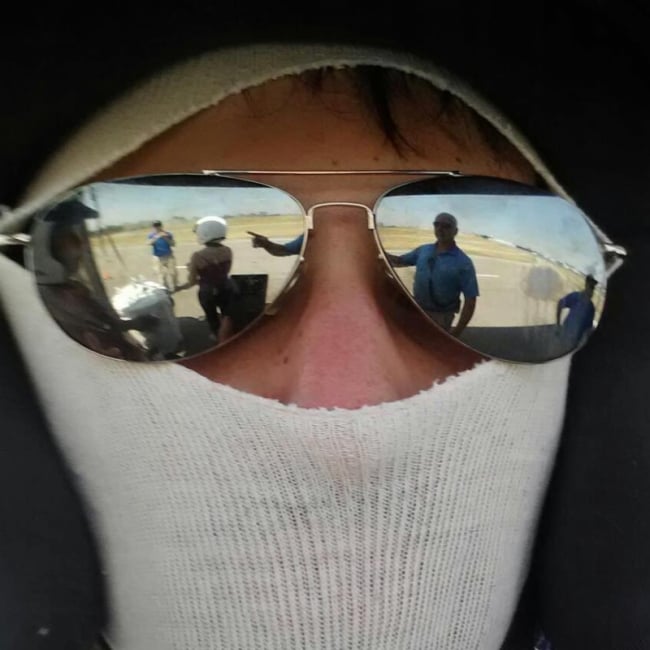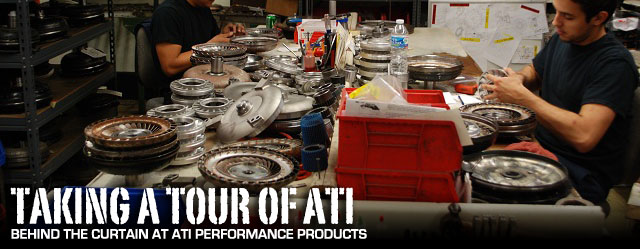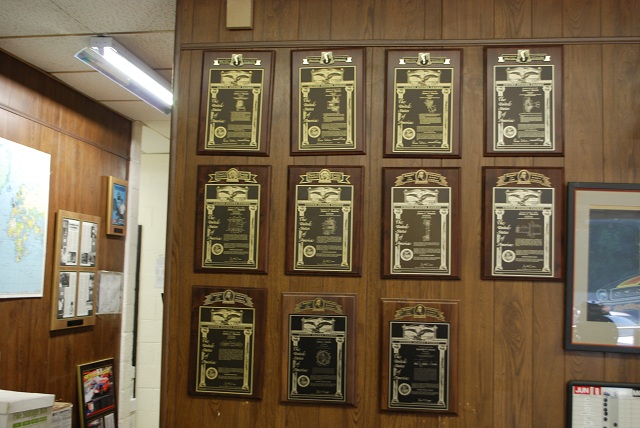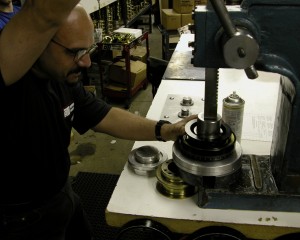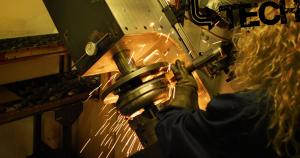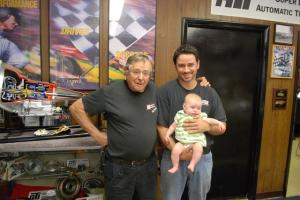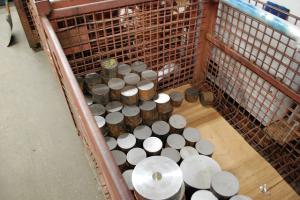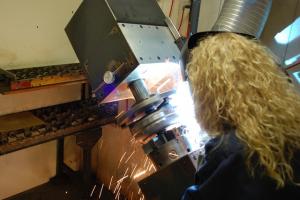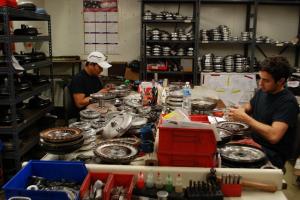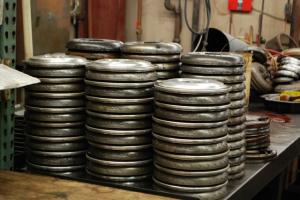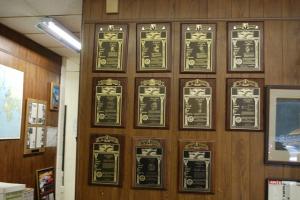When we first strolled into the ATI Performance Products factory located on the outskirts of Baltimore, Maryland, the first thing we noticed was the wall of gold-plated plaques hanging behind the secretary’s desk. “What are those?” We asked.
“Patents,” the secretary responded. “Most of them belong to the owner, J.C. Beattie Sr.” This wall of plaques set the tone for the rest of our tour of the ATI production facilities.
In true American fashion, ATI is a family owned business, though we didn’t expect to find the entire Beattie family working here. Pets included.
Our guide for this tour would be J.C. Beattie Jr., who recently became a father himself. Inside the front office is Jr.’s mother, and his daughter Ava, bouncing happily in her baby carrier.
Sr.’s office is in the back (though not for much longer) right next to the massive machine shop that makes up ATI’s headquarters. Also working at the shop are JC’s girlfriend and a number of close family friends, who are as much family as they are employees.
First Stop: Transmission Cores
The first stop we make on our tour is in the receiving room, when transmission cores come in. “We’re always purchasing transmission cores,” JC Beattie Jr. tells us. “It is a big part of our business, with an emphasis on Powerglides.” ATI currently produces one of the strongest Powerglides on the market, the Superglide4, and JC estimates that anywhere from 30% to 50% of the transmissions they do in a year are of the Powerglide variety. So they’re always looking for a good core get to work on. From there, every part of the transmission is refreshed, replaced, or otherwise improved upon before leaving ATI’s shipping facility across the street.
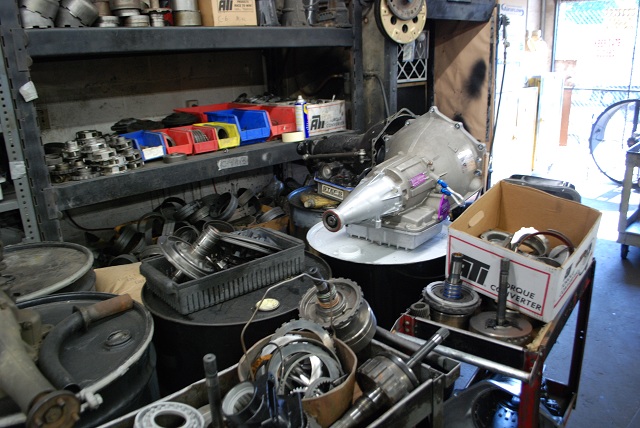
The first stop on our tour was the receiving area, where transmission and torque converter cores arrive.
Just what kind of improvements or refreshing the transmissions get depends on what the customer wants. As mentioned, the Superglide4 is one of the strongest Powerglide on the market. Remember those patents we mentioned earlier? The Superglide4 features a patented input shaft system that significantly improves its strength, which is often considered the “weak link” in modern Powerglide performance transmission. But every ATI transmission gets new internals, either to OEM spec or upgraded for hardcore racing, from the valve body to the shift lever. It just all depends on what you need it for.
In the case of ATI’s top-notch transmission, the SuperGlide4, the upgraded internals are rated at 3,000 horsepower. And like all of ATI’s transmissions, it is thoroughly dyno-tested to that everything is functioning as intended. The transmission must also be leak tested, have all the pressures verified, as well as the flow rate of the pump before being boxed up and shipped off to the customer.
Torque Converter Turnaround
ATI needs more than just transmission cores though. “Another big part of our business are torque converters,” JC Beattie Jr. explains. “And the way we’ve set it up, we can rebuild a torque converter core and ship it back out to the customer in 24 hours or less.” How are they able to turn around a complicated part like a torque converter so quickly? For one, ATI employs a trained crew of rebuilders whose sole job is to take cores apart and rebuild them to customer specs, all of which is done in the same area. But anybody who knows torque converters knows that there are a lot of time and parts involved.
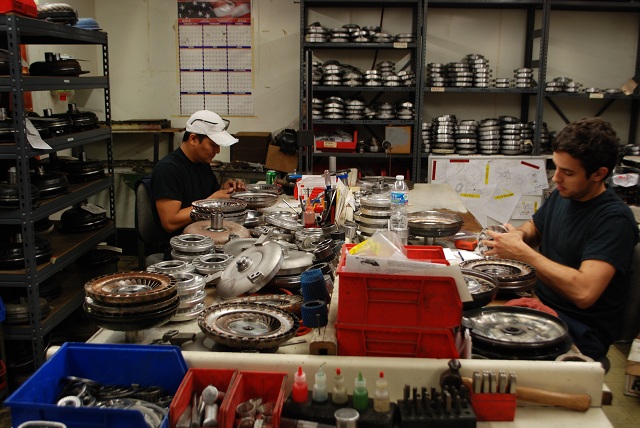
In this room, trained professionals disassemble and reassemble torque converters in as little as 24 hours.
“Pretty much the only thing we don’t have is a foundry,” JC Beattie Jr. says. But what they do have are stacks upon stacks of blanks and CNC machined torque converter parts, many of them made right here in ATI’s facility. ATI also builds and sells torque converter manufacturing equipment, which allows them to produce almost all of the parts they need to rebuild a torque converter to almost any spec.
This means while they may have some blanks shipped in, they do all of the machining and welding in-house, allowing them to ensure the quality right off of their own assembly lines. This also protects them from supply line issues, and allows ATI to maintain an extensive inventory of parts needed to rebuild just about anything having to do with the transmission and torque converter. ATI does more than rebuild torque converts and transmissions though; they make many of the machines needed to produce these components in the first place.
One of their most popular tools (that they sell to many other transmission specialists, including those overseas) is the converter welding system. First developed in 1979 by (who else) JC Beattie Sr., this system “Allows for a precise, controlled weld by clamping on to the torque converter and spinning it around,” says JC Beattie Jr. It is a simple-yet-brilliant design that allows ATI to deliver top quality products and precise welds with an amazing turnaround time.
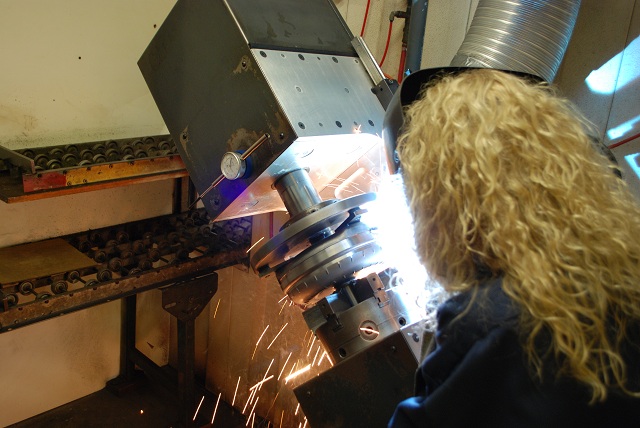
The converter welding machine allows welders to quickly and accurately press and weld together torque converters in very little time.
As we watched from a few feet away, it took the welding technician less than a minute to weld a new torque converter back together. ATI has sold over a 100 of these machines around the world, adding even more depth to ATI’s diverse business model. Other tools they build and sell include a converter leak tester, a cut-open lathe (for opening up an old converter) and a pass-through converter washer. As you might imagine, ATI thoroughly tests all of its transmissions using their own machines before shipping them out to customers and has recently purchased a torque converter dyno for like duty.
Stockpiles of Transmission Parts
The pride JC Beattie Jr. takes in the family business is evident as he shows us the superb welding skills of his crew. Taking apart a half-completed torque converter, he goes over each weld and part, explaining how seriously they take the “Made in America” moniker and that sometimes, the old ways are still the best ways. We’ll see exactly what he means a little later in the tour.
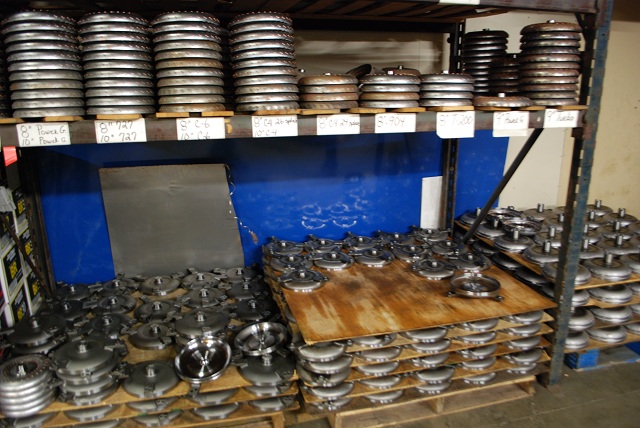
The warehouse and storage containers hold just about everything ATI needs to build torque converters and harmonic dampers. "The only thing we don't have is a foundry," says JC Beattie Jr.
After checking out the torque converter rebuilding station, JC Beattie Jr. leads us through the extensive warehouse, which was in the middle of getting its light bulbs replaced. Not exactly conducive conditions to proper photography, though we did get a good look at a bunch of engines and transmission cores lying around, waiting for their turn at greatness. The back warehouse leads to the back yard, where shipping containers abut the highway, are protected by tall fences topped by barbed wire.
This is where ATI keeps a majority of the transmissions, torque converters, and other cores. A forklift idles in the yard with a longtime family friend sitting on top of it with some bad news; the lift, a used one recently purchased online may have some serious mechanical issues. JC Beattie Jr. looks unhappy, but as he explains, “Even with the cost of repairs, it’ll still save us a lot of money over buying a new one.” And it isn’t the oldest piece of machinery in ATI’s shop, as we’ll soon find out.

ATI uses an eclectic mix of classic and modern machines in their daily operations. Many of the machines in this picture are from around World War II.
Modern Machining and Old School Muscle
After we’re through in the back yard, it is on to the machine shop, the heart and soul of ATI’s business. This is where precise modern CNC machines mix with an eclectic collection of pre-World War II machining devices that still perform their original functions as well as ever. With high tech computerized devices rubbing shoulders with classic mechanical creations, there is a whole lot of work to go around the ATI shop.
“We sell about 12,000 harmonic balancers every year,” says JC Beattie Jr. “It’s a huge part of our business, and about 75% of the machines in our shop are dedicated to making different kinds of dampers.” There’s a reason why ATI harmonic Super Dampers are used in many extreme horsepower applications; they are tested to perform above and beyond the calls of duty, and it is a good thing too, because they have a lot of vibration to absorb.
Harmonic Balancer 101
Let’s take a brief detour just to explain the importance of harmonic dampers. Every time a cylinder fires, vibrations are transmitted via the piston to the connecting rod, and the crankshaft. The crankshaft “deflects,” or bends, and while it may be hard to imagine that huge lump of metal bending, it really does on a microscopic level.
At certain engine speeds, the torque and engine vibrations come into sync and cause resonance, which will stress and crack even the toughest crankshafts. While an engine can last a little while suffering these vibrations, in the long term you’re talking about a spectacular engine failure and huge repair bills if the vibrations are allowed to go on unchecked. Thus, all the effort and testing ATI puts into its harmonic dampers (or balancers, depending on what you want to call them.)
Harmonic dampers are heavy because the mass of the unit resists the acceleration of vibration, and an energy absorbing element (usually rubber or fluid) negates the vibrations. This essentially eliminates resonance and significantly extends the life of a crankshaft. It isn’t hard to imagine why a good harmonic damper is important for extreme racing applications.
“A lot of people rely on our product,” says JC Beattie Jr. “And there are literally millions of dollars of engine parts at stake.” He isn’t kidding. “We provide 100% of the dampers to NASCAR Sprint Cup Cars,” says JC Beattie Jr. Those engines run a lot of very pricey parts that rely on ATI’s damper to keep them together, which why the whole ATI extended family of 50+ employees take their job seriously. But what is it about ATI dampers that make them so popular with the NASCAR crowd?
There are many different types of dampers, though through years of trial and testing ATI has found the most success with the rubber O-ring style elastometer dampers. This style of dampers feature hard rubber bands wrapped around a metal disc. While many OEM elastomer dampers have just one rubber O-ring, ATI’s Super Dampers use multiple rings, and a damper-within-a-damper style.
These dampers also have just four major components; an outer shell, inertia weight (with the elastomer bands), inner shell, and crank hub components. Depending on the application, the outer damper may be as big as seven-inches, and the inner damper just four-inches in diameter, with the inertia weight fitted in between them.
Many studies have shown that elastomer-style dampers have a greater resistance and absorption of vibration than either viscous (liquid) or friction-type dampers. Available in both steel and aluminum, ATI Super Dampers also have the added benefit of being easily rebuildable, something many other damper types can’t lay claim to.
Building a Balancer
The process of building a harmonic balancer begins with a 40-foot long bar of raw metal stock that is cut and shaved right in ATI’s own facilities. The dampers and torque converters are actually built side-by-side, often using the very same machines. Each individual component of the dampers is CNC-machined to exact specifications, and while each damper may only have four parts, those parts must be precisely aligned and thoroughly tested before being sent to customers.
After machining each part, the O-rings are inserted on to the inertia weight by hand before everything is lined up and pressed together. Then the outer shell and interia weight are pressed together, then the inner damper, and finally the crank hub (that attaches to the crankshaft.) And viola! A brand new ATI Racing harmonic damper. But next comes arguably the most important step of all; testing.
That is why ATI invested in a Damper Torsional Testing Machine, which allows ATI to set up an engine or chassis dyno and collect torsional vibration data from the engine. “This machine lets me tune the damper much like you’d tune a carb or engine,” says JC Beattie Jr. “I can take off the damper shell, change the durometer (hardness) of the rubber elastomeror even the entire damper size itself,” until it meets the proper specifications. In case you haven’t noticed, a lot of testing goes into the finished products before they head to the shipping department across the street.
Ship It Out
This is the last stop on our tour, and we came at a time when ATI is in the middle of remodeling the latest addition to the facility. While much of the space inside the warehouse is dedicated to storage (including a huge boxes laden with ATI’s own Super F transmission fluid), ATI is currently adding more office space to house their ever-expanding operation. JC Beattie Sr. will be getting a much bigger office here, and the hope is to streamline their operations even more, shortening the turnaround on rebuilds and getting parts out to their customers in the most expedient way possible.
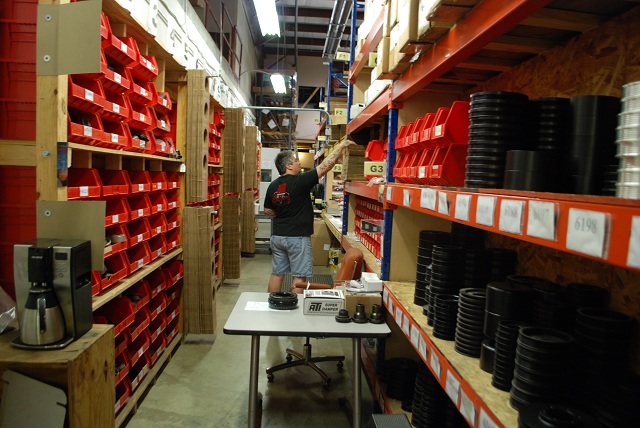
We finished our tour in ATI's vast new warehouse, where row-upon-row of torque converters and harmonic dampers sit waiting for new owners.
That about does it for our tour of ATI’s facility, and we left Baltimore knowing a whole lot more about torque converters and harmonic dampers than we knew before. And while these may not be the most glorious parts of a performance car, their importance cannot be understated. Luckily the Beattie’s are hard at work, testing, tuning, building and rebuilding these oft-overlooked parts to the best of their ability, giving our engines and transmissions an extra dose of longevity.


